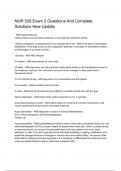NUR 529 Exam 2 Questions And Complete
Solutions New Update
- ANS-Hydronephrosis
Kidney failure from increased pressure on the nephrons Infections (UTIs)
1.Blood coagulation or development of an insoluble fibrin clot - ANS-Third step of hemostasis:
stabilization of the plug occurs as the coagulation pathway is activated on the platelet surface,
and fibrinogen is converted to fibrin.
120 days - ANS-RBC lifespan
2-3 weeks - ANS-acute phase of mono lasts
20 years - ANS-Age when red cell production takes place mainly in the membranous bones of
the vertebrae, sternum, ribs, and pelvis and red marrow changes to fatty yellow due to
decreased activity
3 to 24 months of age - ANS-Age when iron requirements are the highest
4 to 6 weeks - ANS-incubation time for mono
5 years - ANS-Almost all bones produce RBCS to maintain growth rate until this age
Above diaphragm - ANS-Initial lymph node involvement in HL is typically
Acute blood pressure control - ANS-relies mainly on neural and humoral mechanisms, with
neural mechanisms producing the most rapid response
Acute pericarditis - ANS-diagnosis is based on clinical manifestations.
ECG, chest radiography, and echocardiography
Friction rub
Acute pericarditis - ANS-manifestations include a triad of chest pain, pericardial friction rub, and
electrocardiographic (ECG) changes. Nearly all people have chest pain, which is usually abrupt
in onset and sharp, occurring in the precordial area, and may radiate to the neck, back,
abdomen, or side. The pain is typically worse with deep breathing, coughing, swallowing, and
positional changes because of changes in venous return and cardiac filling. The person often
finds relief by sitting up and leaning forward. It is important to differentiate the chest pain from
acute myocardial infarction (MI) or pulmonary embolism (PE).
,Acute pericarditis - ANS-pericardial inflammation of less than 2 weeks, may occur as an isolated
disease or the result of systemic disease
Acute postinfectious glomerulonephritis - ANS-usually occurs after infection with certain strains
of group A beta-hemolytic streptococci and is caused by deposition of immune complexes of
antibody and bacterial antigens.
It also may occur after infections by other organisms, including staphylococci, a viral agent
(such as hepatitis), and various parasites.
Although the disease is seen primarily in children, people of any age can be affected.
Acute regulation of blood pressure - ANS-(seconds to minutes) is necessary to correct
temporary imbalances and during life-threatening situations.
Acute tubular necrosis - ANS-prolonged ischemia, nephrotoxic drugs, intratubular obstruction
from hemoglobinuria, myoglobinuria, uric acid casts, acute renal disease (glomerulonephritis,
pyelonephritis)
o Tubular epithelial cells are most at risk for ischemia due to their high metabolic rate (also
vulnerable to toxins) can be reversible! (NSAIDS, ACE inhibitors, dye/contrast are bad)
adolescents and young adults - ANS-Mono highest incidence in
Afterload - ANS-The pressure it must generate to pump the blood out of the ventricle
Aldosterone - ANS-promotes sodium reabsorption by the kidney, resulting in an increased
vascular volume and an increased B/P.
Aldosterone antagonists/Potassium sparring diuretics - ANS-Mild effect
o Reduce Na+ reabsorption & decrease K+ secretion in the late distal tubule and tubule sites
ruled by aldosterone,
2 types:
o Act as direct aldosterone antagonists i.e., spironolactone
o Act independently of aldosterone
Anemia - ANS--An abnormally low number of circulating red blood cells or level of hemoglobin,
or both
-Results in diminished oxygen-carrying capacity
Anemia in CKD - ANS-can be caused from:
o Chronic blood loss (from dialysis), hemolysis, uremia suppressing bone marrow function, iron
deficiency(from diet), impaired erythropoietin production (kidneys are primary site for this) which
impairs RBC production
Angiotensin II - ANS-powerful vasoconstrictor that causes BP to rise (humoral mechanism)
, Angiotensin II - ANS-stimulates the adrenal cortex to secrete aldosterone.
aorta - ANS-carries blood to the body
Aortic semilunar valve - ANS-located between the left ventricle and the aorta
Atrial septal defect - ANS-flaw in the septum that divides the two atria of the heart
Atrial septal defect - ANS-Intracardiac shunting is usually from left to right and may increase
with age as the right ventricle becomes more compliant. In most cases, there is a moderate
shunt, resulting in dilation of the right heart chambers
Baroreceptors - ANS-Stretch sensitive receptors
Monitor blood pressure
Bronchiolitis - ANS-Produces inflammatory obstruction of the small airways and necrosis of the
cells lining the lower airways.
Most affected infants have a history of respiratory infections. Infant can take in enough air but
has trouble exhaling it
Can lead to RF as evidenced by increased RR, retractions or grunting,
Bronchiolitis - ANS-viral infection of the lower airways usually caused by RSV (Respiratory
syncytial virus).
Bronchiolitis age group - ANS-<2 years (most severe in infants younger than 6 months)
Bronchiolitis symptoms - ANS-Preceded by stuffy nose, causes Breathlessness, rapid, shallow
breathing, wheezing, cough, and retractions of the lower ribs and sternum during inspiration
Bronchiolitis treatment - ANS-Supportive treatment, possibly nebulization therapy or intubation
depending on situation
BUN - ANS-influenced by protein intake, hydration, and GI bleeding
2/3s (66%) of kidney fxn must be lost before rises
Usually less than 20
Calculi causing urinary tract obstruction - ANS-urinary tract obstruction with Acute pain &
hematuria
Cardiac Cachexia - ANS-A condition of severe malnutrition that develops in heart failure
patients; characterized by weight loss and tissue wasting.
Cardiac contractility - ANS-is the ability of the heart to change its force of contraction without
changing its resting (diastolic) length, strongly influenced by the number of calcium ions




